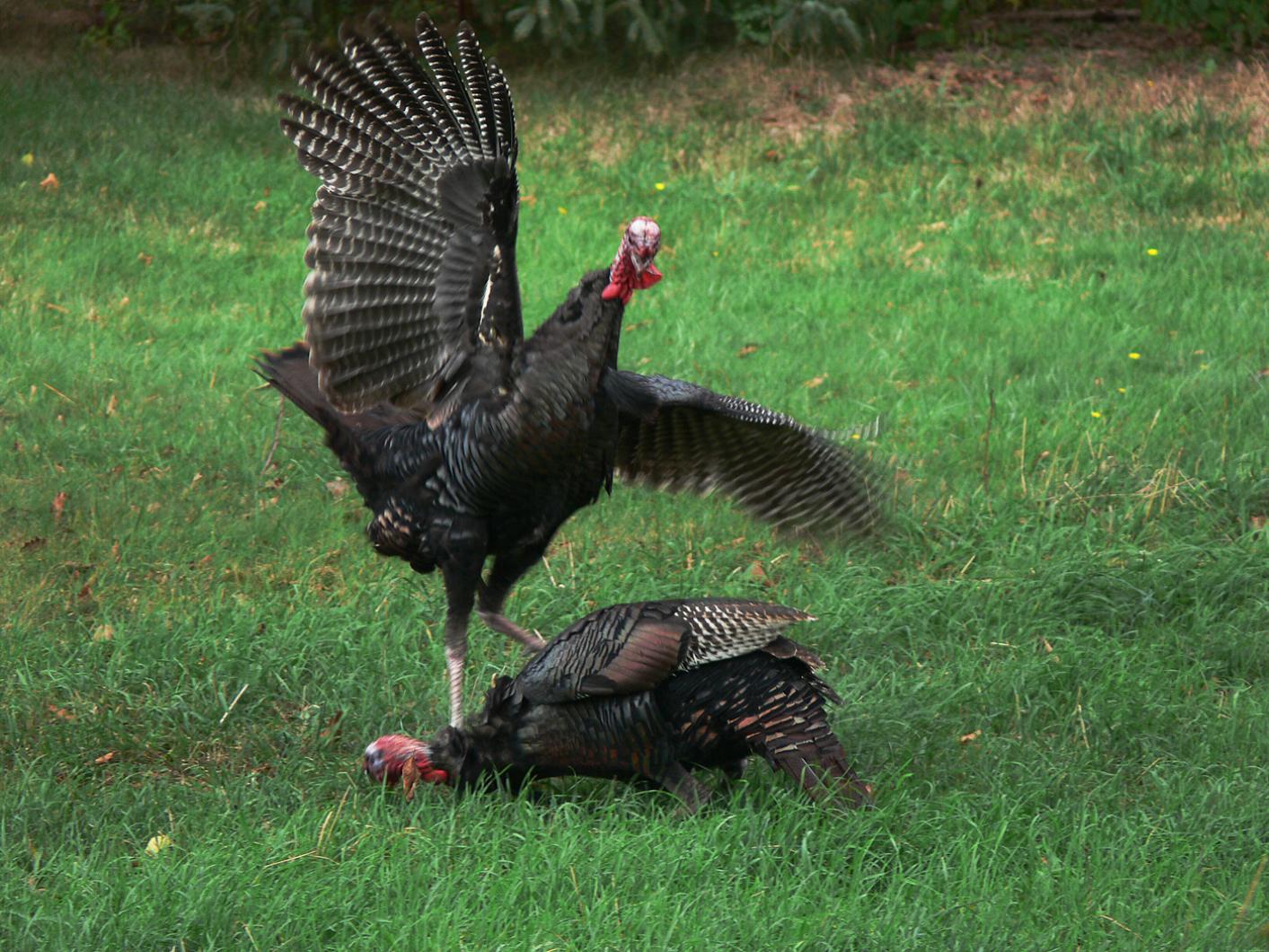Announcing that there are no wild turkeys on Martha’s Vineyard is akin to breaking the news that there is no Santa Claus. But that is the truth whether you like it or not. Barbara Pesch and I noted in Vineyard Birds 2 that wild turkeys were introduced by Gus Ben David from Arkansas in the 1970s. These wild turkeys were extirpated in the 1990s. What the heck are all the turkeys that are wandering around the Vineyard from Aquinnah to Edgartown?
Feral turkey is the answer. Elisha Smith, a farmer from Katama, raised domestic turkeys in that area and Craig Kingsbury had a flock of domestic turkeys on the West Tisbury/Tisbury line. Somewhere along the line these two populations met up and interbred, so what we are seeing around the Island are domestic birds gone “wild.”
A wild turkey is a very wary bird — they would never have to be herded off a road or shooed off a porch. Wild turkeys are much more streamlined than their domestic cousins and sport brown-tipped, not white-tipped tail feathers. The wild turkey’s legs are extremely powerful and during a normal day they will range between four and five square miles looking for water and food. These same legs are capable of propelling the wild turkey at speeds up to 25 miles per hour. If sprinting doesn’t take the turkey out of harm’s way, it can take to the air and fly at 50 miles per hour.
The pilgrims started the tradition of serving turkeys at Thanksgiving. Four birds were part of their first harvest dinner. However, it was these same pilgrims and the settlers that followed that almost caused the demise of the wild turkey. These birds prefer woodlands and as the forests were cleared for farmland, the turkeys declined drastically by 1900. Conservation efforts reversed this trend and now wild turkeys can be found in 42 states, but not on Martha’s Vineyard.
The courtship is quite spectacular. The males, called toms or gobblers, put on quite a show both verbally and physically. The gobble of a tom turkey is a common voice in the forest in spring, although any loud noise can produce several gobbles at any time of year. The male with his strutting and gobbling collects several hens, a harem. After mating the hens sneak away and lay their dozen eggs in a slight depression in the woods. Twenty-eight days later the poults (baby turkeys) are born. The male has nothing to do with nest building, incubation or rearing the young. He just hangs out with other toms. No wonder they are called turkeys!
Bird Sightings
Morning Glory Farm fields are the location of a lesser black-backed gull spotted by Warren Woessner on Nov. 24. Down at the end of Herring Creek Farm where it meets Ocean drive, Warren counted 50 snow buntings flying around his van.
A great story came from Bert Fischer back in early November. He had a Cooper’s hawk kill one of his laying hens. Instead of burying the hen, he put it in his crab pot and caught three blue claw crabs which he proceeded to use to stuff the quahogs he harvested. A lesson in how to make a good thing out of a bad situation! On Nov. 7 Bert counted three snow buntings at Squibnocket.
Nov. 19 Lanny McDowell and Allan Keith found a flock of horned larks, a female peregrine falcon, and one American pipit at the Farm Institute at Katama plus several snow buntings and counted 8 to 10 Ipswich sparrows at Norton Point.
Nov. 8 Allan Keith had hooded mergansers on Black Point Pond, and Nov. 18 Allan counted six Ipswich Sparrows at Quansoo
Nov. 6 Lanny McDowell, Pete Gilmore and Bob Shriber spotted seven hooded mergansers at Tom’s Neck on Chappaquiddick and a greater yellowlegs at Wasque.
Luanne Johnson spotted a horned grebe in Squibnocket Pond on Nov. 7. Lisa Wright e-mailed me that they have a pair of noisy belted kingfishers at Cuttyhunk.
Nov. 21 Peter Enrich spotted six purple sandpipers and a great blue heron at Squibnocket. The same day Happy and Steve Spongberg had a hermit thrush in their Chilmark home bird-bath. Pat Hughes and Hal Minis spotted a peregrine falcon, several northern gannets and a female harlequin duck at Squibnocket on the same day. I spotted a female purple finch at my Quenames feeder on Nov. 20 and Allan Keith came down and saw it as well.
Allan Keith, Lanny McDowell and I birded Hancock Beach and Quenames on Nov. 21 and spotted two American robins, buffleheads, red-breasted mergansers, red-throated loons, surf and white-winged scoters, great blue herons, two American wigeons, two dunlins, a northern harrier and a northern flicker.
Nov. 22 Pat Hughes and Hal Minis joined me at Black Point where we saw most of what we had seen the day before but added eight ring-necked ducks and a sharp-shinned hawk.
Lanny McDowell, and Richard and Toni Cohen spotted a late staying female Baltimore oriole by the old Edgartown dump.
Please report your bird sightings to the Martha’s Vineyard Bird Hotline at 508-627-4922 or e-mail to birds@mvgazette.com.




Comments
Comment policy »